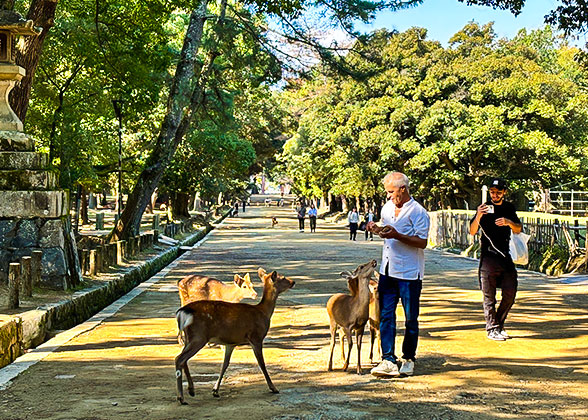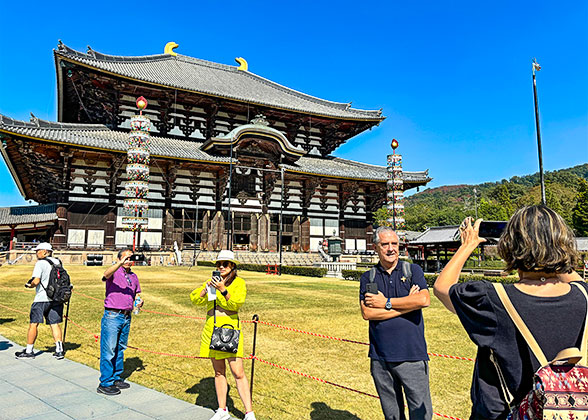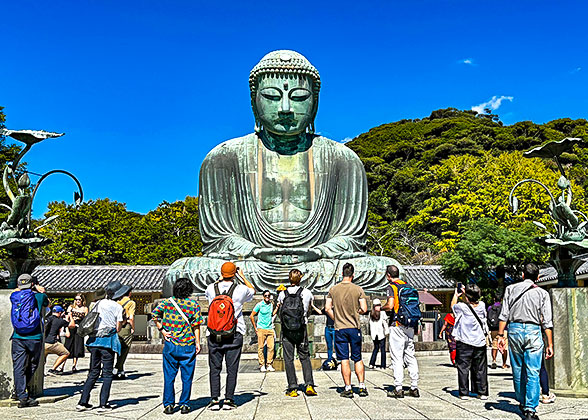Kofukuji Temple
Kofukuji Temple is located in the west of Nara Park. It was established in 710, and consists of many ancient buildings, among which the Five-storied Pagoda, Eastern Golden Hall, Northern Round Hall, and Three-storied Pagoda are national treasures of Japan. Besides, it preserves a number of national treasures and important cultural property related to Buddhist culture. You can spend about one hour exploring and appreciating the Buddhist culture and architectural style.The roaming deer in Kofukuji Temple make the stately temple lively. You can buy deer cracker to feed them, and each small bag of cracker is about 200 Yen. However, some deer like to pester the visitors. You can spread your hands flat to tell them that you don't have any food at all.
What is Worth Seeing in the Kofukuji Temple?
1. Five-Storied Pagoda
The Five-Storied Pagoda is not only the symbol of the Kofukuji Temple but also the representative pagoda of Nara. The temple is about 50 meters (164 feet) high and is the second-tallest wooden pagoda in Japan. The highest five-storied pagoda in Japan is Toji Temple, which is located in Kyoto. The Five-Storied Pagoda in Kofukuji Temple was initially established in 730 by Empress Kōmyō, and rebuilt five times successively. The current Five-Storey Pagoda was established in 1426, and it combines the architectural style of the Nara Period and the Muromachi Period.

Kofukuji Temple Photos ( 17
|
2. National Treasure Hall

National Treasure Hall in Kofukuji Temple
|
Ticket: 700 yen
Opening Hours: It is open from 9:00 to 17:00, all year round.
3. Eastern Golden Hall
Eastern Golden Hall was established in 726, and Emperor Shōmu (701-756) ordered it to be built in order to pray for the health for his aunt, Empress Genshō (680-748). The hall was rebuilt several times after fire, and the current hall was built in 1915. You can appreciate the treasured Buddhist statues inside, including varied Bronze statues and wood statues.Ticket: 300 yen.
Opening Hours: It is open from 9:00 to 17:00, all year round.
Note: Combo ticket is 900 yen, and it contains tickets for National Treasure Hall and East Gold Hall.
4. Central Golden Hall
The Central Golden Hall is the most important central building in Kofukuji. The hall was originally established between 710 and 714, and it altogether suffered from six destructions. The current Central Golden Hall was reconstructed in 2018 and is the newest building in Kofukuji Temple. The building combines the traditional Japanese carpentry and architectural style of the Nara period, enabling offspring to explore and know about the building of thousands of years ago. You can see varied images and statues of different Buddhist figures inside.Ticket: 500 yen
Opening Hours: It is open from 9:00 to 17:00, all year round.

Central Golden Hall in Kofukuji Temple
|
5. Three-storied Pagoda
The Three-storied Pagoda was originally established in 1143 under the order of Empress Fujiwara no Kiyoko (1122-1182). The current Three-Storey Pagoda was built in 1181, making it one of the two oldest buildings in Kofukuji Temple. The pagoda is 19 meters (62) high and is known for its delicate lines and elegant exterior. Inside, the pillars, walls, ceiling, and doors are painted with Buddhist images.6. Northern Round Hall
The Northern Round Hall was originally established in 721 in order to commemorate the death of Fujiwara no Fuhito, who was the founding patron of the Kofukuji Temple. The current hall was established in 1210 and is the other oldest building in Kofukuji Temple beside the Three-storied Pagoda. The hall contains a number of important Buddhist statues and the expressions of these statues are unique and funny and you can observe them in detail.7. Southern Round Hall
The Southern Round Hall is an important cultural property of Japan, and it was originally established in 813. The significant icon of the hall is the statue of Fukūkensaku Kannon with three eyes, eight arms, and deerskin on its left shoulder. Its first two hands are closed in front of its chest. The second hands are on either side of the hips. The third left hand holds a lotus flower and the right a monk’s cane. The fourth left hand holds a snare and the right a flywhisk. You can try to find all arms of the statue on site.

Southern Round Hall in Kofukuji Temple
|
Visit Tip
Before entering the temple, you can perform a simple ritual at the sink like the locals do, which means both your body and mind are clean while visiting the temple. It is like this: use the spoon to pour a little water into the left hand, then the right hand, then wash your mouth with the water from the spoon, and finally stand the spoon up and let the rest of the water flows down to clean both hands.How to Get to Kofukuji Temple
1. Take the Kintetsu Nara Line, and get off at Kintetsu Nara station. It is about a five-minute walk to Kofukuji Temple.2. Take the JR Nara Line, and get off at JR Nara station. It is about a twenty-minute walk to Kofukuji Temple. Besides, you can take Nara Kotsu Bus at JR Nara station, and get off at Kenchōmae Bus Stop, which takes about 8 minutes.
|
|
|
Ticket:
You can visit Kofukuji Temple for free, but some of the halls charge as mentioned above.Travel Advice:
After visiting Kofukuji Temple, you can continue to explore other attractions in Nara Park, like Todaiji Temple, Mountain Wakakusa, Kasuga Taisha Shrine, Himuro Shrine, Nara National Museum, Gangoji Temple, and Isuien Garden, or simply enjoy more fun with the cute deer in the park. Besides, you can walk to visit Higashimuki Shopping Street to taste Nara cuisine.See more:




